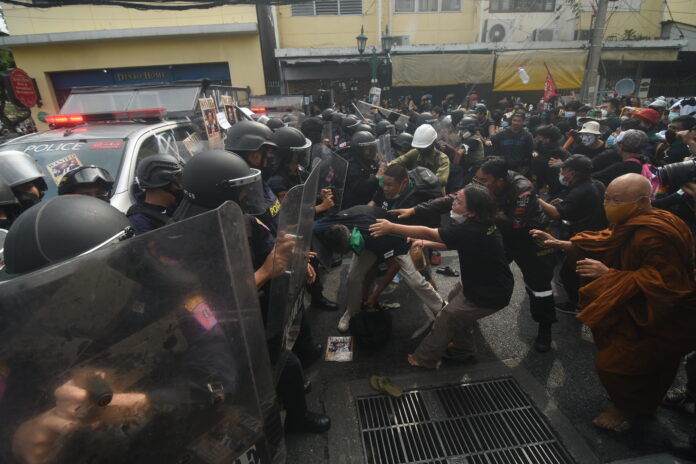
In what has become a vicious cycle, riot police needlessly and heavy-handedly disperse protesters using rubber bullets and more, leading to serious injuries or even death, and this is followed by demand for accountability and transparency.
On Nov. 18, the dispersal of the anti-government-cum-anti-APEC protest, was just another such needless crackdown and injuries. One young key protester, Payu Dao Din, 28, was hit by a rubber bullet at his right eye, resulting in a severely ruptured eyeball and the chance of restoring the vision is very slim even after several operations.
The hospital where he is being treated is now providing him with psychological advice to assist the young protester to cope with the new reality that he may not be able to see with his right eye again. On top of that, a male journalist for one online Thai-language news agency was dragged away when the dispersal took place on Din Sor Road, just a stone’s throw away from Democracy Monument.
It was a needless dispersal because the protesters were seven kilometers away from the APEC Summit venue. Also, there were just around 200 unarmed protesters and police could have simply contained them at the site until the summit was over, or better still, allowed a handful of protest leaders to travel to the summit site to hand over the demands in writing.
Unfortunately, and tragically for Payu, riot police charged at the protesters to disperse them after protesters engaged in a Thai Voodoo ritual of burning of chili and salt to curse PM Gen. Prayut Chan-o-cha. Riot police could simply have extinguished the fire then just left the protesters where they were for the next 24 hours. But they did not.
Days after the dispersal, the protesters called the incident “bloody APEC” and demanded that police apologize, reveal the names of officers involved, and compensate for the damage incurred. Protesters gave police 15 days to respond, and a deputy police chief came out of the national police headquarters to accept the letter.
We do not know how the police will respond two weeks from now, but national police chief Pol. Gen. Damrongsak Kittiprapas already stated hours after the beating of a reporter that “the press must help themselves” because such situation involved many people and could led to a case of “mistaken” identity.
Damrongsak made no mention that in the video clip, we could hear one riot police relishing in the beating by telling the beaten journo, “This is the real stuff.” It apparently was not self-defense on the part of the police.
In order to avoid future such tragedies, Thailand needs a new standard in crowd handling, transparency, and accountability. A system must be in place where an independent committee is set up to look into the incident where serious injuries or death occurred, and the committee members must be composed of not just senior police officers, but outsiders including a representative of the protesters as well.
One cannot expect the police’s own inquiry to be fair or independent. A report then should be released to the public and if any misconduct occurred, those officers involved should be punished. Anything less than that would likely mean there will be more needless casualties like Payu in the future.











































